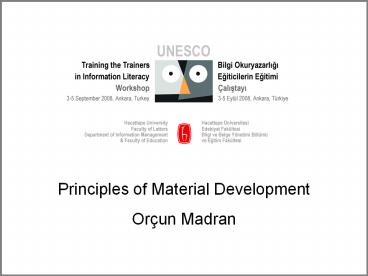Principles of Material Development - PowerPoint PPT Presentation
1 / 36
Title:
Principles of Material Development
Description:
UNESCO Training the Trainers in Information Literacy Workshop September 3-5 Ankara Turkey ... in Information Literacy Workshop September 3-5 Ankara Turkey ... – PowerPoint PPT presentation
Number of Views:701
Avg rating:3.0/5.0
Title: Principles of Material Development
1
Principles of Material Development
- Orçun Madran
2
Outline
- How We Learn?
- What We Remember?
- Instructional Methods
- Learning Objects
- Visual Design
3
How we learn?
4
What we remember?
10
READ
20
HEAR
30
SEE
50
HEARSEE
70
SAY
DO
90
5
Instructional Methods
- Presentation
- Demonstration
- Discussion
- Drill-and-Practice
- Tutorial
- Cooperative learning
- Gaming
- Simulation
- Discovery
- Problem solving
6
Which instructional method?
- Presentation
- Demonstration
- Discussion
- Drill-and-Practice
- Tutorial
- Cooperative learning
- Gaming
- Simulation
- Discovery
- Problem solving
- We have to combine them
- more visual elements
- more interactivity
7
What kind of material?
Easy to create Easy to offer Easy to access
Reusable
8
Learning Objects
- The term learning object generally refers to a
reusable component at the page, lesson, or,
perhaps, course level.
9
Learning Objects
10
Learning Objects
11
Advanteges of Learning Objects
12
Visual Design
- General Principles
- Materials which are well-designed
- Makes learning easier.
- Makes learner creative.
13
Good Visual Design
- Presents your instructional material in a clear
and appealing manner. - Makes your material easily understood.
14
How can I make good design?
- Use the visual design principles to improve your
design. - Critically examine your work to see if the
message design can be improved. - Keep things simple.
15
Visual Design Principles
- Harmony
- Balance and Symmetry
- Emphasis
- Alignment
- Closure
16
Harmony
- Harmony refers to the way that the elements of a
display interact together in a pleasing manner.
Lack of harmony
17
Harmony
18
Harmony (Killer)
19
Harmony Tips (3 x 3 Matrix)
20
Harmony Tips (3 x 3 Matrix)
21
Harmony Tips (3 x 3 Matrix)
22
Harmony Tips (3 x 3 Matrix)
23
Balance and Symmetry
- Elements of differing sizes can be brought into
balance, by moving them closer to or farther from
the center of the page (Like a seesaw). - Balance in visual design is preferable to
imbalance. - Symmetry is achieved when one half of a visual
display is a mirror image of the other half.
24
Balance and Symmetry
25
Balance and Symmetry
26
Emphasis
- Emphasis is used by designers to create dominance
and focus in their work. - Designers can emphasize color, value, shapes, or
other design elements to achieve dominance.
27
Emphasis
New user account
28
Emphasis
29
Alignment
- Alignment of elements within a screen is an
important part of organizing and grouping. - If at all possible, you should align elements in
such a way as to visually maximize differences
between different kinds of text, labels and
pictures
30
Alignment
31
Alignment
32
Alignment
33
Closure
- People tend to fill in missing bits, and perceive
visuals as complete, or closed, entities.
34
Closure
- People also tend to group closer objects.
(unity provided)
(unity lost)
35
Bibliography
- Çagiltay, K. Instructional Technology and
Material Developments Course Materials. Retrieved
August 1, 2008, from METU Open Courseware Project
Web site http//ocw.metu.edu.tr/computer-educatio
n/instructional-technology-and-material-developmen
ts - Gülbahar, Y. Instructional Technology and
Material Developments Course Materials. Retrieved
July 25, 2008, from http//www.baskent.edu.tr/gul
bahar/dersler/egt301.php - McClurg-Genevese, J.D. The Principles of Design.
Retrieved August 3, 2008, from http//www.digital-
web.com/articles/principles_of_design/ - Seferoglu, S. S. (2006). Ögretim Teknolojileri ve
Materyal Tasarimi (3rd ed.). Ankara Pegem A
Yayincilik. - Yalin, H. I. (2006). Ögretim Teknolojileri ve
Materyal Gelistirme (17th ed.). Ankara Nobel
Yayin Dagitim.
36
Orçun Madran
- omadran_at_baskent.edu.tr

